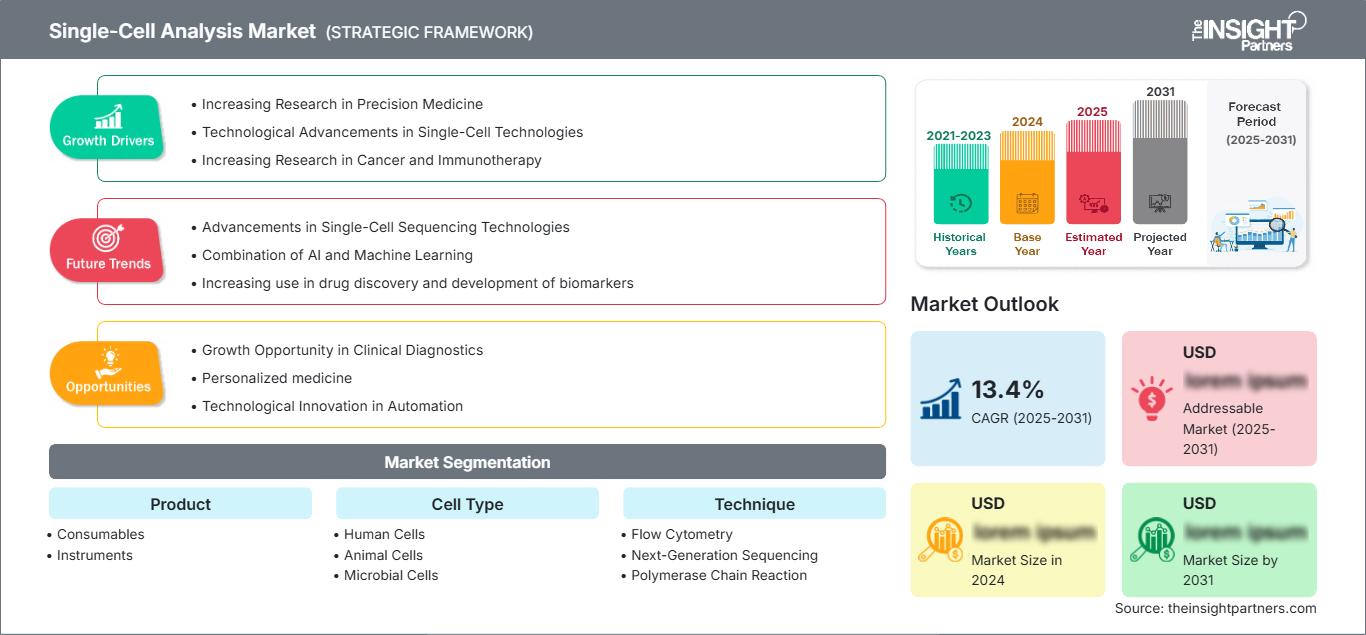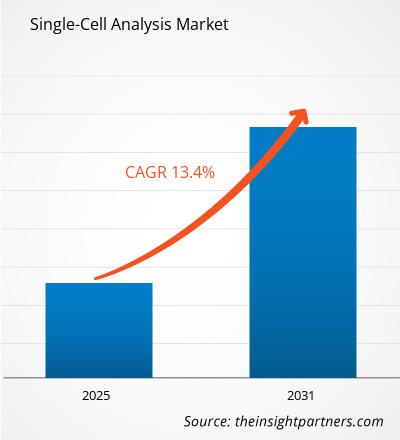Der Markt für Einzelzellanalysen wird bis 2031 voraussichtlich ein Volumen von 14,35 Milliarden US-Dollar erreichen. Für den Zeitraum 2025–2031 wird ein jährliches Wachstum von 15,7 % erwartet.
Der Markt für Einzelzellanalysen ist nach Produkten in die Segmente Verbrauchsmaterialien und Instrumente unterteilt. Die Analyse basiert auf Zelltypen (menschliche, tierische und mikrobielle Zellen), Analysetechniken (Durchflusszytometrie, Next-Generation-Sequenzierung, Polymerase-Kettenreaktion, Mikroskopie, Massenspektrometrie und weitere Techniken), Anwendungsbereichen (Forschung und Medizin) sowie Endnutzern (akademische und Forschungslabore, Biotechnologie- und Pharmaunternehmen, Krankenhäuser und Diagnostiklabore, Zellbanken und IVF-Zentren). Die globale Analyse wird nach Regionen und wichtigen Ländern aufgeschlüsselt. Die Marktbewertung für die oben genannte Segmentanalyse wird in US-Dollar dargestellt.
Zweck des Berichts
Der Bericht „Markt für Einzelzellanalyse“ von The Insight Partners beschreibt die aktuelle Marktlage und das zukünftige Wachstum sowie die wichtigsten Treiber, Herausforderungen und Chancen. Er bietet Einblicke für verschiedene Akteure im Markt, darunter:
- Technologieanbieter/Hersteller: Um die sich entwickelnde Marktdynamik zu verstehen und potenzielle Wachstumschancen zu erkennen, können sie fundierte strategische Entscheidungen treffen.
- Investoren: Um eine umfassende Trendanalyse hinsichtlich Marktwachstumsrate, Finanzprognosen und Chancen entlang der Wertschöpfungskette durchzuführen.
- Regulierungsbehörden: Um Richtlinien zu regulieren und Aktivitäten auf dem Markt zu überwachen, mit dem Ziel, Missbrauch zu minimieren, das Vertrauen der Investoren zu wahren und die Integrität und Stabilität des Marktes zu gewährleisten. Marktsegmentierung für Einzelzellanalysen: Produkt
- Verbrauchsmaterialien
- Instrumente
Zelltyp
- Menschliche Zellen
- Tierische Zellen
- Mikrobielle Zellen
Technik
- Durchflusszytometrie
- Sequenzierung der nächsten Generation
- Polymerase-Kettenreaktion
- Mikroskopie
- Massenspektrometrie
- Sonstige Techniken
Anwendung
- Forschungsanwendungen
- Medizinische Anwendungen
Endnutzer
- Akademische und Forschungslabore
- Biotechnologie- und Pharmaunternehmen
- Krankenhäuser und Diagnostiklabore
- Zellbanken und IVF-Zentren
Passen Sie diesen Bericht Ihren Anforderungen anSie erhalten kostenlos Anpassungen an jedem Bericht, einschließlich Teilen dieses Berichts oder einer Analyse auf Länderebene, eines Excel-Datenpakets sowie tolle Angebote und Rabatte für Start-ups und Universitäten.
Markt für Einzelzellanalysen: Strategische Einblicke

-
Holen Sie sich die wichtigsten Markttrends aus diesem Bericht.Dieses KOSTENLOSE Beispiel umfasst Datenanalysen, die von Markttrends bis hin zu Schätzungen und Prognosen reichen.
Wachstumstreiber des Marktes für Einzelzellanalyse
- Zunehmende Forschung in der Präzisionsmedizin: Mit dem Fokus auf personalisierte Medizin steigt auch der Bedarf an Einzelzellanalysen, um die Mechanismen von Krankheiten und gezielte Therapien besser zu verstehen.
- Technologische Fortschritte in der Einzelzelltechnologie: Fortschritte in der Einzelzellsequenzierung, der CRISPR-Genomeditierung und der Mikrofluidik tragen zum Wachstum der Einzelzellanalyse bei, da all diese Verbesserungen genauere und effizientere Analysen ermöglichen. Zunehmende Forschung in Krebs und Immuntherapie: Die Einzelzellanalyse wird zunehmend in der Krebsforschung eingesetzt, insbesondere zur Untersuchung der Tumorheterogenität sowie des Ansprechens auf Immuntherapien, was das Marktwachstum antreibt. Zukünftige Trends im Markt für Einzelzellanalysen: Fortschritte bei Einzelzellsequenzierungstechnologien: Die Einzelzell-RNA-Sequenzierung (scRNA-seq) revolutioniert die Genexpressionsanalyse und ermöglicht es Forschern, die zelluläre Diversität und Entwicklungsprozesse aufzudecken. Kombination von KI und maschinellem Lernen: KI wird für die riesigen Datenmengen, die in Einzelzelltechnologien generiert werden, eingesetzt, um bessere Einblicke und schnellere Ergebnisse zu erzielen.
- Zunehmende Nutzung in der Wirkstoffforschung und Biomarkerentwicklung: Die Einzelzellanalyse wird in der Forschung nach neuen Markern für die Krankheitsdiagnose und Therapieentwicklung eingesetzt, insbesondere in der Onkologie und Immunologie.
Marktchancen der Einzelzellanalyse
- Wachstumspotenzial in der klinischen Diagnostik: Die Einzelzellanalyse bietet Expansionsmöglichkeiten in der klinischen Diagnostik, insbesondere in der Onkologie, da sie die diagnostische Kompetenz verbessert.
- Personalisierte Medizin: Individuelle Therapien, die auf dem Verhalten der Zellen basieren, eröffnen neue Wege für die Präzisionsmedizin und präzisere, zielgerichtete Therapien.
- Technologische Innovation in der Automatisierung: In großen Forschungs- und klinischen Laboren bestehen enorme Chancen bei der Entwicklung automatisierter Einzelzellanalysesysteme, die Kosten senken und den Durchsatz erhöhen.
Markt für Einzelzellanalyse
Die regionalen Trends und Einflussfaktoren auf den Markt für Einzelzellanalysen im gesamten Prognosezeitraum wurden von den Analysten von The Insight Partners ausführlich erläutert. Dieser Abschnitt behandelt außerdem die Marktsegmente und die geografische Verteilung des Marktes für das Management von Herzrhythmusstörungen in Nordamerika, Europa, dem asiatisch-pazifischen Raum, dem Nahen Osten und Afrika sowie Süd- und Mittelamerika.
Umfang des Marktberichts zur Einzelzellanalyse
By Zelltyp- menschliche Zellen
- tierische Zellen
- mikrobielle Zellen
- Durchflusszytometrie
- Next-Generation-Sequenzierung
- Polymerase-Kettenreaktion
- Mikroskopie
- Massenspektrometrie
- andere Techniken
- Forschungsanwendungen
- medizinische Anwendungen
- Großbritannien
- Deutschland
- Frankreich
- Russland
- Italien
- Restliches Europa
- China
- Indien
- Japan
- Australien
- Restlicher Asien-Pazifik
- Brasilien
- Argentinien
- Restliches Süd- und Mittelamerika
- Südafrika
- Saudi-Arabien
- Vereinigte Arabische Emirate
- Restlicher Naher Osten und Afrika
Berichtsattribut Einzelheiten Marktgröße in 2024 US$ XX Billion Marktgröße nach 2031 US$ 14.35 Billion Globale CAGR (2025 - 2031) 15.7% Historische Daten 2021-2023 Prognosezeitraum 2025-2031 Abgedeckte Segmente By Produkt - Verbrauchsmaterial
- Instrumente
Abgedeckte Regionen und Länder Nordamerika - USA
- Kanada
- Mexiko
Marktführer und wichtige Unternehmensprofile - Agilent Technologies
- Beckman Coulter Inc.
- Becton Dickinson & Company (BD)
- Bio-Rad Laboratories, Inc.
- Fluidigm Corporation
- GE Healthcare
- Illumina, Inc.
- Merck KGaA
- Qiagen N.V.
Einzelzellanalyse-Marktteilnehmerdichte: Auswirkungen auf die Geschäftsdynamik
Der Markt für Einzelzellanalysen wächst rasant, angetrieben durch die steigende Nachfrage der Endnutzer. Gründe hierfür sind unter anderem sich wandelnde Verbraucherpräferenzen, technologische Fortschritte und ein wachsendes Bewusstsein für die Vorteile des Produkts. Mit steigender Nachfrage erweitern Unternehmen ihr Angebot, entwickeln innovative Lösungen, um den Kundenbedürfnissen gerecht zu werden, und nutzen neue Trends, was das Marktwachstum zusätzlich beflügelt.

- Holen Sie sich die Markt für Einzelzellanalysen Übersicht der wichtigsten Akteure
Wichtigste Verkaufsargumente
- Umfassende Abdeckung: Der Bericht bietet eine umfassende Analyse der Produkte, Dienstleistungen, Typen und Endnutzer des Marktes für Einzelzellanalyse und vermittelt so ein ganzheitliches Bild.
- Expertenanalyse: Der Bericht basiert auf dem fundierten Wissen von Branchenexperten und Analysten.
- Aktuelle Informationen: Der Bericht gewährleistet Geschäftsrelevanz durch die Berücksichtigung aktueller Informationen und Datentrends.
- Anpassungsmöglichkeiten: Dieser Bericht kann an spezifische Kundenanforderungen angepasst werden und sich optimal in die Geschäftsstrategien integrieren.
Der Forschungsbericht zum Markt für Einzelzellanalyse kann somit maßgeblich dazu beitragen, das Branchenszenario und die Wachstumsaussichten zu entschlüsseln und zu verstehen. Auch wenn einige berechtigte Bedenken bestehen, überwiegen die Vorteile dieses Berichts insgesamt die Nachteile.
- Historische Analyse (2 Jahre), Basisjahr, Prognose (7 Jahre) mit CAGR
- PEST- und SWOT-Analyse
- Marktgröße Wert/Volumen – Global, Regional, Land
- Branchen- und Wettbewerbslandschaft
- Excel-Datensatz
Aktuelle Berichte
Verwandte Berichte
Erfahrungsberichte
Grund zum Kauf
- Fundierte Entscheidungsfindung
- Marktdynamik verstehen
- Wettbewerbsanalyse
- Kundeneinblicke
- Marktprognosen
- Risikominimierung
- Strategische Planung
- Investitionsbegründung
- Identifizierung neuer Märkte
- Verbesserung von Marketingstrategien
- Steigerung der Betriebseffizienz
- Anpassung an regulatorische Trends






















 Kostenlose Probe anfordern für - Markt für Einzelzellanalysen
Kostenlose Probe anfordern für - Markt für Einzelzellanalysen